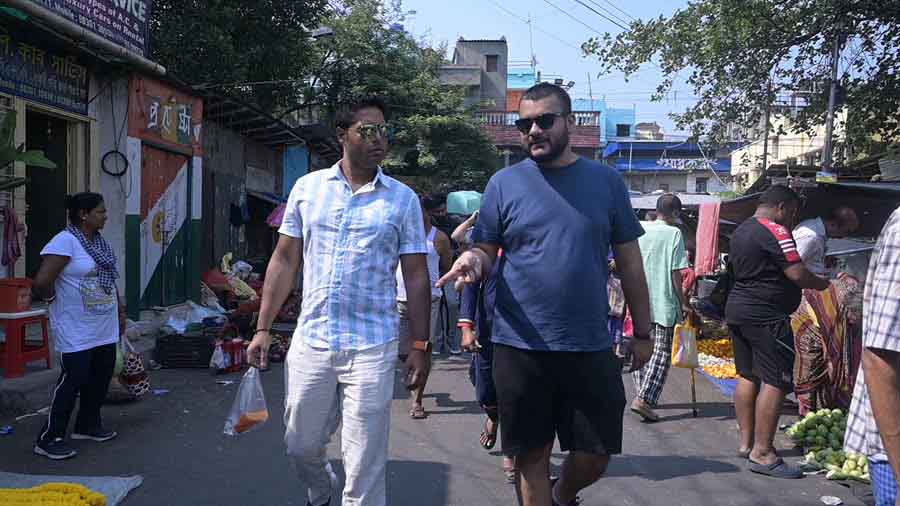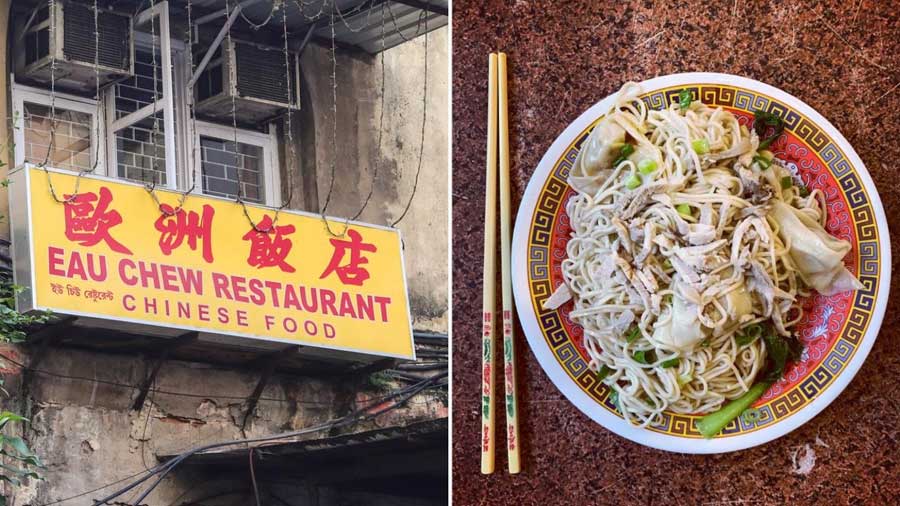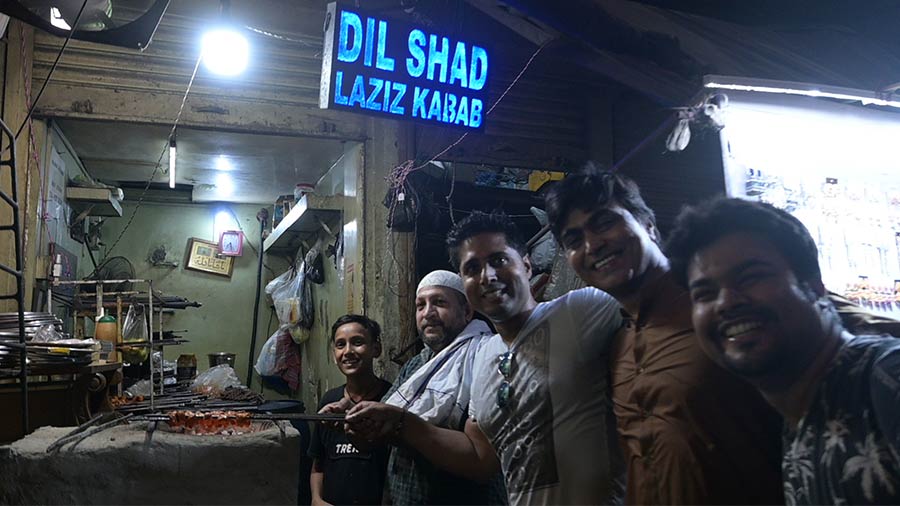The story of food never begins and ends on a plate. Instead, it is constantly born and reborn through the context and the characters that shape it and are shaped by it. The conception of food as a cerebral, even visceral, experience is common among uncommon foodpreneurs, people who champion food in ways that excite the mind as well as the mouth. Roni Mazumdar, the Kolkata boy running six Indian restaurants in New York, and Auroni Mookerjee, the executive chef of Sienna Cafe, are two such foodpreneurs who are both rebels and revolutionaries when it comes to gastronomy. On April 22, they met in the City of Joy to explore fresh produce, flavours and their food philosophies.
A day after being named Bochorer Best for 2022 at Anandabazar Online’s annual felicitation of outstanding Bengali achievers at the ITC Royal Bengal, Roni went on a mini food tour of Kolkata. The itinerary was curated by Auroni, who had just returned to the city from Delhi, where Sienna had a Poila Baisakh pop-up earlier in April. Intent on celebrating authentic regional cuisine that believes in “intimacy with ingredients”, Roni and Auroni are changemakers with a common cause — they want Indian and Bengali food to return to its roots instead of moulding itself to fit the demands of the market, or worse still, mundane palates.
‘It’s like I’ve time travelled to 30 years in the past’
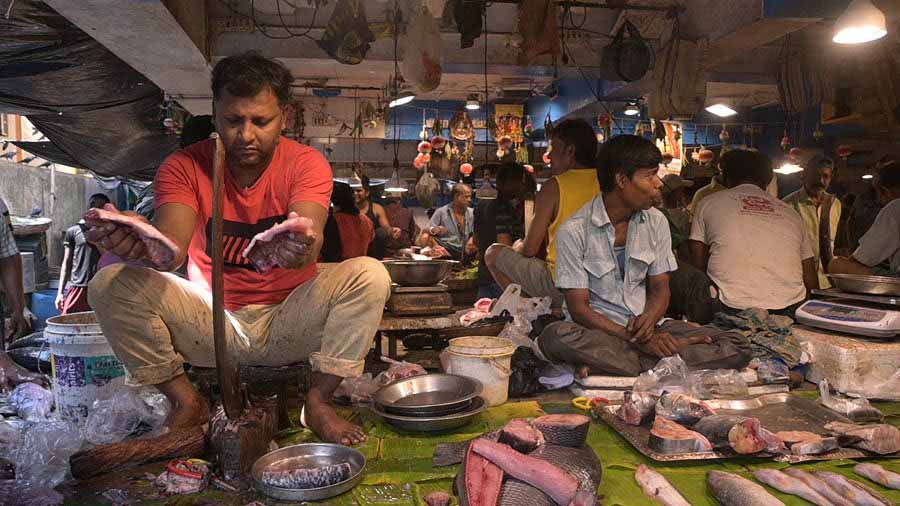
Some of the fish on offer at Ultadanga’s Muchibazar Market
With Roni being in Kolkata for just a few days, Auroni had a clear goal — to introduce Roni to the best of Kolkata’s local food space, while also giving him a taste of how Auroni approaches food at Sienna. With the April heat relenting somewhat, the tour got underway at 8.30 in the morning, with Avinandan Kundu from Sienna and Sukrit Sen, heritage and disaster management professional and musician, in tow. The first port of call was Ultadanga’s Muchibazar Market, frequented by Sienna’s team members for the finest snails, fish and vegetables. “It’s like I’ve time travelled to 30 years in the past. I feel like I’m back in the Kolkata I had left for the US in the ’90s,” said Roni, as he sampled multiple ingredients and bought some aamshotto along the way.
As Auroni explained the dynamics of the bazaar to Roni, including the role of the “shak maashis” (women selling leafy vegetables), it was clear that the two men had hit it off, bouncing off ideas and engaging in deep conversation about what the vibes at a bazaar reveal about a city’s approach to food. “When a Bengali comes to shop for fish, it’s often about buying what feels good or right on the day. There’s an element of whim to it, that’s the whim we need to bring to a Bengali restaurant,” said Auroni, who changes a part of the Sienna menu every day depending on the produce he finds in the morning.
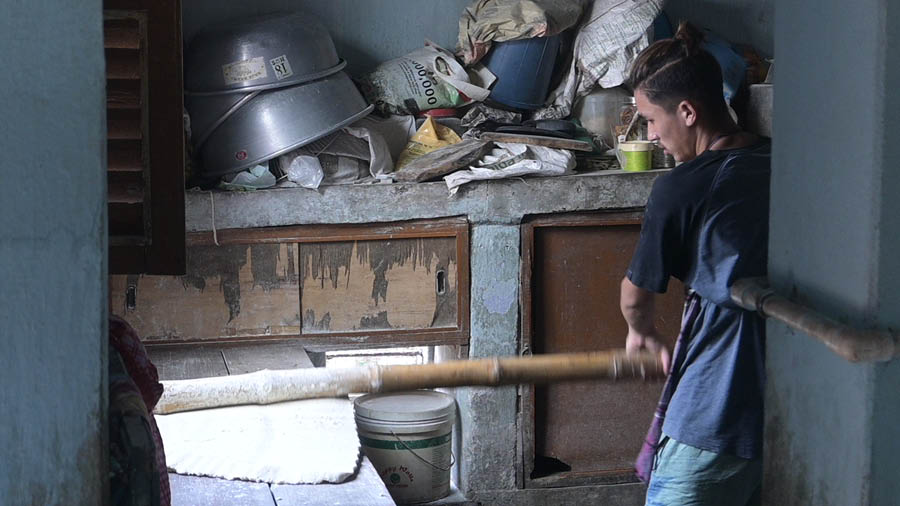
Noodles being made the good old way at Tangra’s Ah Leung
After a brief Malai Kulfi break, the food tour left Ultadanga for Tangra, where the next stop was Ah Leung, a small but succulent Chinese joint located deep into the bowels of Kolkata’s second Chinatown. “It’s amazing to think that a restaurant can exist in the middle of nowhere and still pull in customers,” marvelled Roni, whose admiration for Ah Leung, which has been around for the past three decades, went up after he saw noodles being made by hand in the classic, laborious way. “This is our (Sienna team’s) favourite place for Chinese food in the city,” said Auroni, before ordering some chilli chicken, chilli pork and Singara Chow (not with the real singara!). Roni loved the meal and appreciated how Ah Leung “only does a select few items but does them with aplomb”.
‘Things seem to be chaotic, but they also follow their own order at Kolkata’s bazaars’
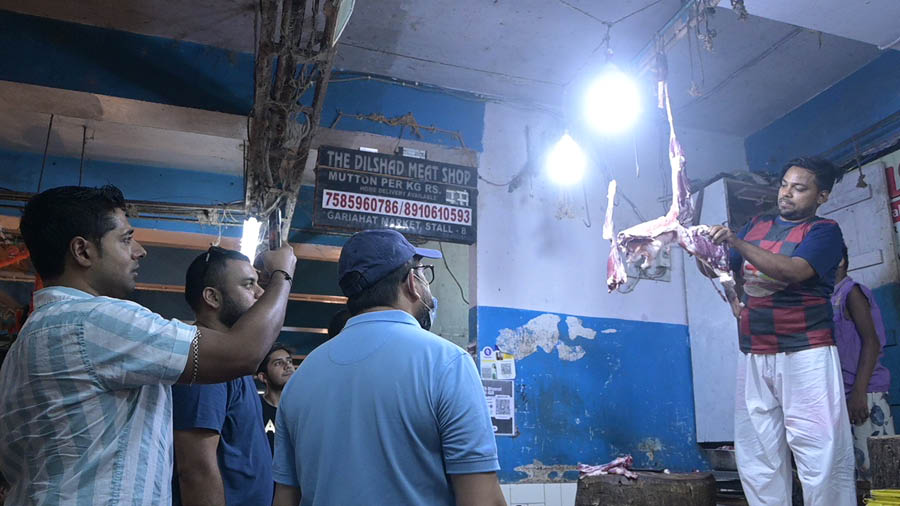
Roni likes what he sees in terms of the meat cuts at Gariahat Bazaar
Off to Gariahat bazaar next, which My Kolkata readers might remember as the place the city’s greatest fish lover, Chandan Pandit, took us around last year. But for Auroni and Roni, it was more than fish on the agenda in one of Kolkata’s busiest and largest food markets. “Just look at this cabbage and the sheer size of it, no way you’re getting this in New York,” chuckled Roni, who was presented with some delicately crafted Goyna Bori by Auroni. Looking at the cuts of meat available at Gariahat’s New Poultry Centre (where Auroni invariably gets his mutton from), Roni called it a “radically different product (as compared with the US)”, since the “texture and the fat content (the good, old chorbi) are gamechangers”.
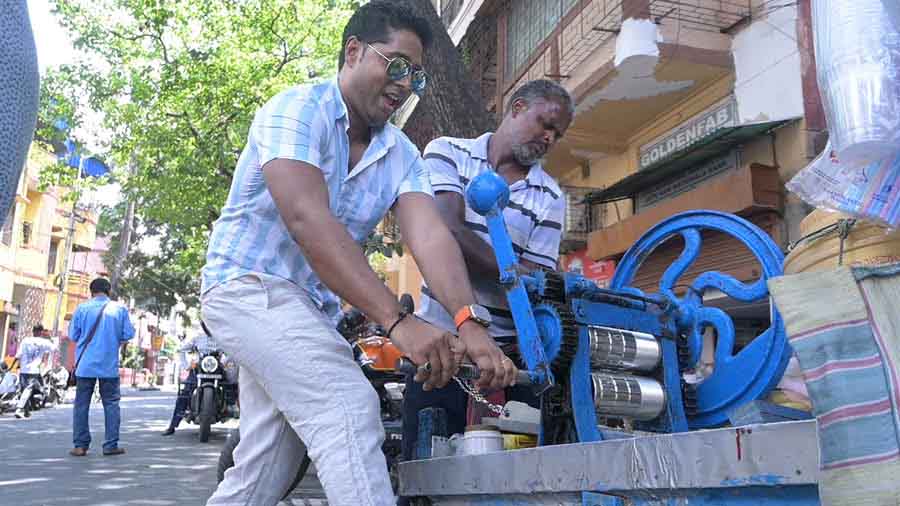
Roni has a go at churning out some sugarcane juice for the group
This was followed by a quick survey of a pice hotel within the confines of the market and some snacking on kochuri. “There’s a certain hierarchy in a bazaar in Kolkata. Things seem to be chaotic, but they also follow their own order, their own rhythm. The authenticity that you feel here can’t be mimicked,” said Roni, who went on to do his pre-lunch workout by churning out some sugarcane juice for the group moments later.

Roni takes in the vibes at Sienna Store, adjacent to Sienna Cafe
With the necessary miles covered for the afternoon, Roni and Auroni arrived at Sienna Cafe just after midday to partake of a special lunch, one prepared especially for Roni’s visit. “The use of space here is fantastic, I’m dying to try out the food,” declared Roni, after jaunting around Sienna with Auroni. What came thereafter was a degustation meant to showcase the possibilities of Bengali food when combined with bold thinking and refined cooking.
‘He has reignited my hopes in Kolkata’s food scene’: Roni on Auroni
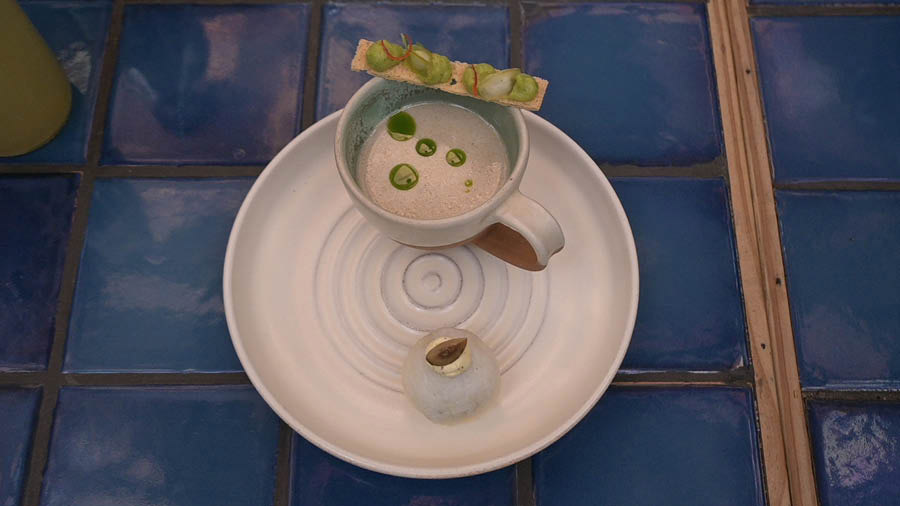
‘Eat your “teto” (bitter) vegetables’, the Sienna way
For the first course, Auroni served something he called “Eat your teto (bitter) vegetables”. This included a fistful of rice stocked with bitter vegetables, presented with a delicious broth of “shukto without shukto” and a thin slice of crispy toast.
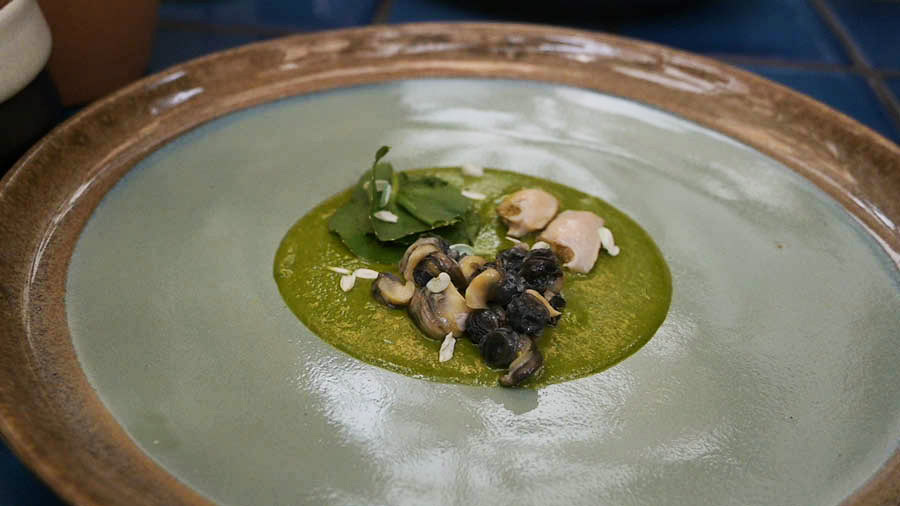
Snails and mussels in a bitter sauce
Next in line was snails and mussels, cooked in a bitter green sauce that seemed even better when had with some butter-infused bhaat. “These are all variations of recipes that I ate growing up, especially from my grandmother. Historically, all these dishes we’re eating today were originally made over decades by pairs of hands that cooked without any validation, as their skills and dedication were taken for granted,” explained Auroni.
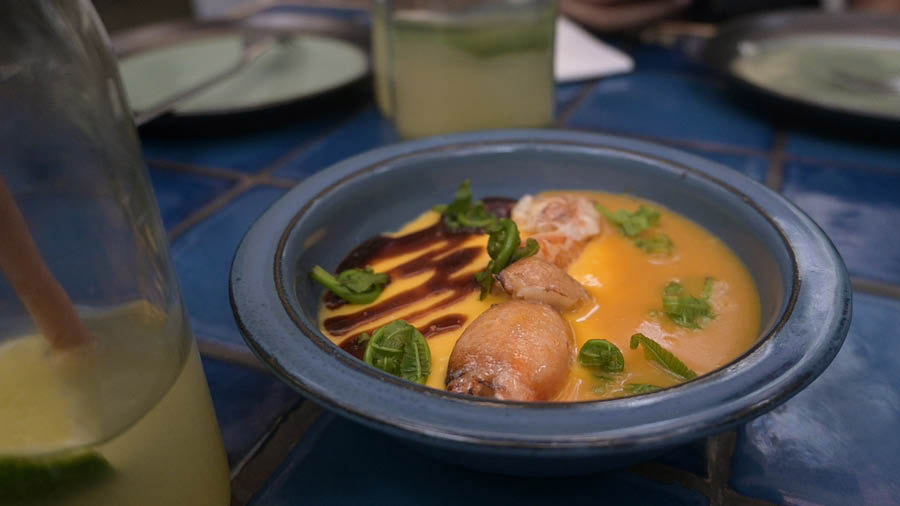
Crab Ghilu with scrambled eggs and prawn caramel sauce
Having stimulated the appetite of the lunchers with a fair bit of bitterness, the first couple of dishes gave way to a yellow, creamy gravy of Crab Ghilu (the insides of the crab’s brains), with scrambled eggs and a caramel sauce made from chingri (prawns) thrown in for good measure.

A deboned Ilish Maachh served with Gola Bhaat and bharta
The fourth course, and the hero of the entire meal, was a massive Ilish Maachh, which Auroni’s team had “lovingly deboned”, served with Gola Bhaat, some tok (sour chutney) and an exquisite bharta made from ilish er lyaja (the tail end of the hilsa). Roni described the bharta as the most sumptuous thing he had tasted all day, with Auroni graciously giving him a jar of the same to take back to New York.
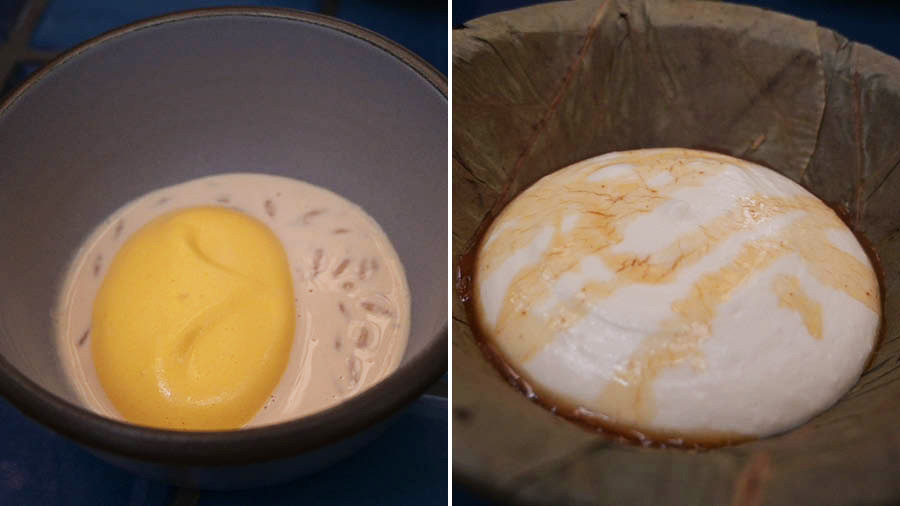
(Left) Choshi Payesh with Mango Sabayon and (right) Makha Sandesh
For desserts, there was Choshi Payesh with mango sabayon and Makha Sandesh, which brought a blockbuster Bengali fusion taste-athon to a sweet culmination. “When I was coming to Kolkata, I was wondering who are the chefs doing things differently in the city. The ones celebrating regional food in ways that do justice to the culture and the context. I’m glad to have found Auroni doing just that. He has reignited my hopes in Kolkata’s food scene,” said Roni. “It was an absolute pleasure to host Roni. My own hopes in food revived after I moved to Kolkata, and I’m glad that Roni got a taste of that today. I now want him to spread the word in New York, so that more people come from the US to try our food here,” said Auroni.

Roni flanked by Avinandan Kundu (left) and Auroni
As Roni and Auroni embraced and parted company, there was a mutual appreciation of something unique having taken place. A moment in time when two pioneers had come together to share their vision, with one of them laying out a spread that had as much food for thought as it had thought for food.
